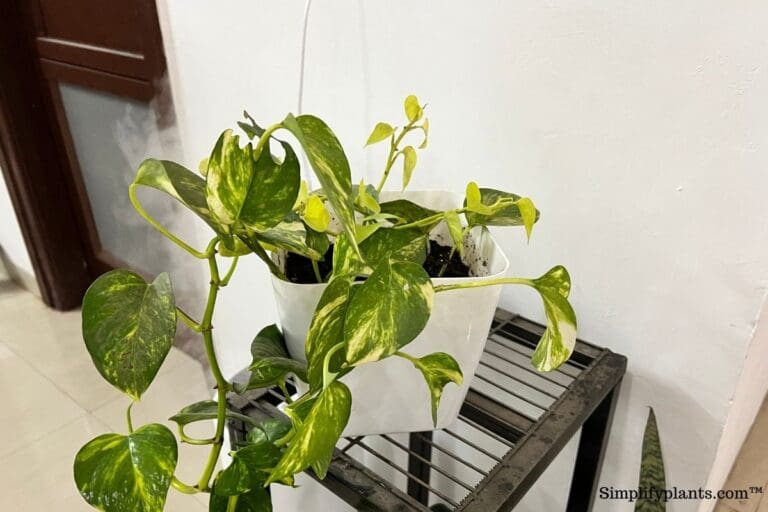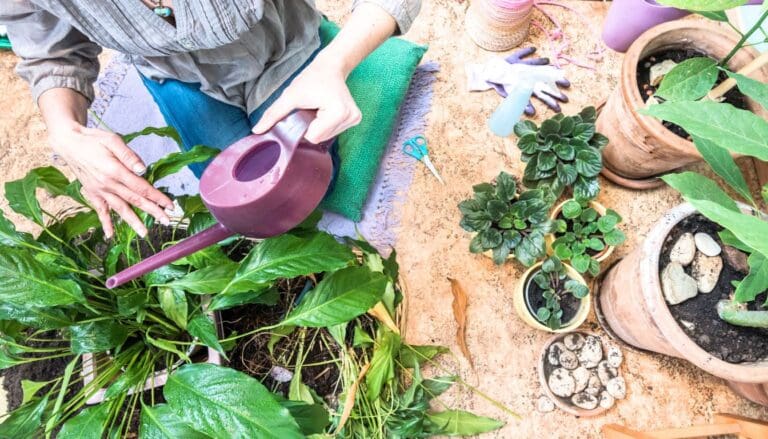Pothos Leaves Still Turning Yellow Despite Proper Care? Try This!
Waking up to see Pothos having yellow leaves is disappointing and alarming. We houseplant lovers don’t want our plants to suffer and stay unhappy. In my 12 years of experience, I have seen my pothos turning yellow for various reasons. Let’s understand them.
Pothos leaves turn yellow due to improper watering habits, wrong light conditions, lack of nutrients, extreme temperatures, poor drainage, rootbound, repotting stress, or infestations. Analyze your plant to understand the actual reason and solve it for a fast recovery.
If your Pothos have yellow leaves, this article can help you understand the common reasons behind it, proper treatment, and tips to prevent yellowing in the future. So, let’s begin without further delay.

Please note: Simplify Plants is reader-supported. Some links in the post are affiliate links and I get a commission from purchases made through links in the post.
1. Pothos Leaves Turning Yellow Due to Incorrect Watering
If Pothos stands in excess water, its roots become waterlogged, lacking oxygen, causing suffocation, and leading to slow rotting.
Overwatering is the reason.
Pothos cannot receive enough moisture and nutrients under such conditions.
Photosynthesis and chlorophyll are inhibited.
As a result, the leaves will gradually turn yellow.
On the other hand, underwatering keeps the roots dehydrated.
Absorbing moisture and nutrients from bone-dry soil is a real struggle for Pothos.
Therefore, Pothos leaves will wilt and turn yellow.
Another issue is inconsistent watering, where watering is irregular, and the soil keeps cycling between arid and oversaturated soil.
It stresses the plant and triggers yellowing.
Also read: Overwatering Vs. Underwatering Plants: Signs, Fix & More.
Pothos watering and moisture management to control yellowing
To prevent yellowing in Pothos, adjust your watering habits.
Check the moisture level 1-2 times a week, and water your Pothos when the top few inches are dry.
Insert your finger or a stick 2-4 inches deep into the soil.
The soil’s top 2-4 inches should be dry and slightly moist below 2-4 inches.
Please track how often your plant absorbs water because it can vary based on the climate. Soil dries faster in summer than in winter.
Once you have enough experience, you can make a watering schedule to follow without any watering issues.
I water my Pothos every 5-7 days in spring and summer and every 7-15 days during the fall and winter.
I always check the moisture once a week and let the top few inches dry before watering.
If needed, I increase or reduce the gap between each watering session.
2. Yellow Pothos Leaves from Poor Soil Quality
If watering is not the issue in your Pothos, drainage is undoubtedly the problem.
Poorly drained soil holds moisture for a long time.
Root stays in stagnant water for too long, suffocates and fails to transfer the moisture and nutrients to the plant, leading to yellowing.
The same happens while using a pot with no drainage holes, as extra water cannot escape.
Soil with poor retention qualities can also cause yellowing because it drains moisture and nutrients before the plant can absorb them.
Another issue is infertile soil. After repotting, you don’t feed for a few weeks.
The soil should provide the required nutrients.
But infertile soil won’t provide enough nutrients, leading to yellow leaves.
Pothos soil health and composition to prevent yellow leaves
Plant your Pothos in fertile, well-drained soil.
To improve soil health, add ingredients like perlite or vermiculite to improve drainage and compost for retention and nutrition.
Use the right soil blend for Pothos initially while planting or repotting to prevent yellowing.
Want some recommendations? Below are some:
- Miracle-Gro Tropical Potting Mix, 6 qt. – Growing Media for Tropical Plants Living in Indoor and Outdoor Containers
- House Plant and Tropical Plant Potting Soil, Repotting Soil for All Types of Indoor House Plants, House Plant Repotting Soil, 8qt
- FoxFarm FX14054 Happy Frog Potting Soil, 12 Quart
Homemade soil mix recipes:
- Add 2 parts peat or coco coir, 1 part perlite, and 1 part pine bark fines.
- Mix one part cactus soil mix and one part compost.
3. Inadequate Lighting Leading to Yellowing Pothos Leaves
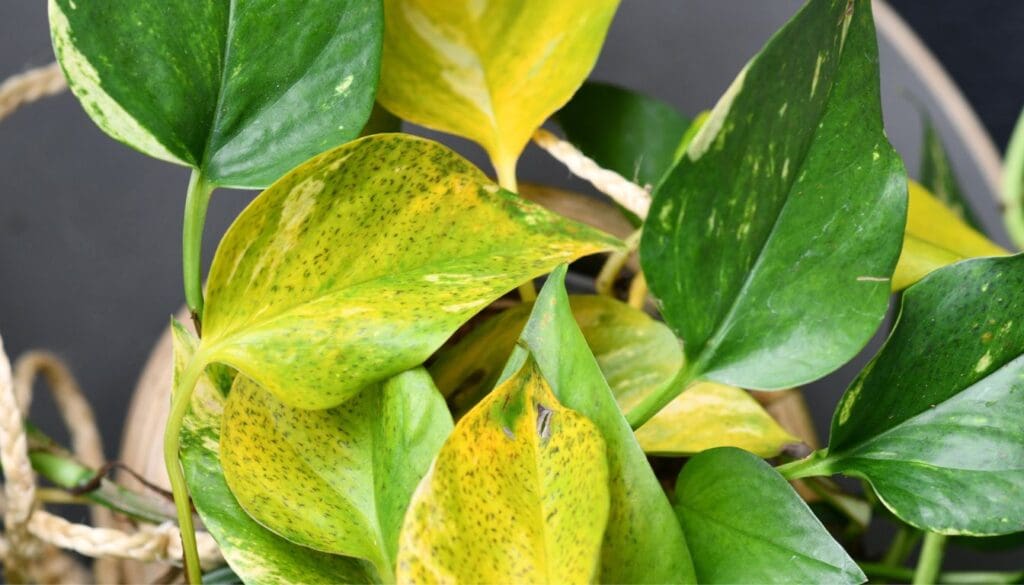
Pothos enjoy bright to medium indirect sunlight for 10-12 hours.
Pale or yellow leaves in Pothos might indicate foliage burn due to full sun exposure.
Let me share something with you.
A few months back, I received a DM from one of my readers struggling with yellowing in Pothos. She also sent me a photo.
I saw her Pothos under direct sunlight and understood the issue.
I immediately suggested removing it from direct sunlight and relocating it somewhere with filtered light.
After a few weeks, she again messaged and told me that her plant was doing excellent after relocation.
On the other hand, Pothos can tolerate low light, but that doesn’t make them ideal for dark corners.
Sunlight is needed for chlorophyll production and is responsible for the leaf’s green pigment.
Lack of sunlight prevents the plant from producing chlorophyll, causing yellow leaves.
Fixing Pothos light conditions to treat yellowing
South or west-facing windows provide direct sunlight maximum times.
If Pothos shows yellow leaves in direct sunlight, move it 8-9 ft. away or to a spot with filtered light.
If you don’t want to remove your Pothos, put up sheer curtains or Venetian blinds.
If your Pothos receives low light, shift it to a bright location or use artificial Grow lights.
Put your pothos plant in an east-facing window for perfect, gentle sunlight. You don’t even have to put up any filters.
4. Poor Fertilization Causes Yellow Leaves in Pothos
Soil alone cannot provide all the nutrients to your Pothos.
Moreover, the nutrients get depleted after some time.
So, you must fertilize it.
Due to nutrient deficiency, Pothos cannot produce chlorophyll, triggering yellowing.
Even the new leaves will grow yellow.
Overfertilization also causes yellowing because the excessive salt from fertilizer accumulates in the soil and burns the roots.
When roots are damaged, the transfer of nutrients and moisture is not smooth. The stress triggers yellowing.
Pothos nutrient management and solution for fertilizer burns to avoid yellowing
If your Pothos has yellow leaves, remember the last time you fertilized.
Feed your pothos plant immediately, if you haven’t for a long time, with a liquid fertilizer (10-10-10 or 20-20-20 NPK) for a quick dose.
If you have yellow leaves in Pothos despite fertilization, recall how frequently you have fertilized it.
If it’s been too often, flush off the soil.
Water your Pothos deeply until the excess comes out.
Let the soil dry, and do it again. Continue for 2-3 times until all the accumulated salts flush out.
Stop fertilizing for a few weeks until you see recovery signs.
Always dilute the fertilizer to half the recommended strength.
Use liquid fertilizers every 4-6 weeks and slow release 1-2 times a year only throughout the spring and summer. Avoid it in winter.
5. Rootbound Pothos Exhibiting Yellow Leaves
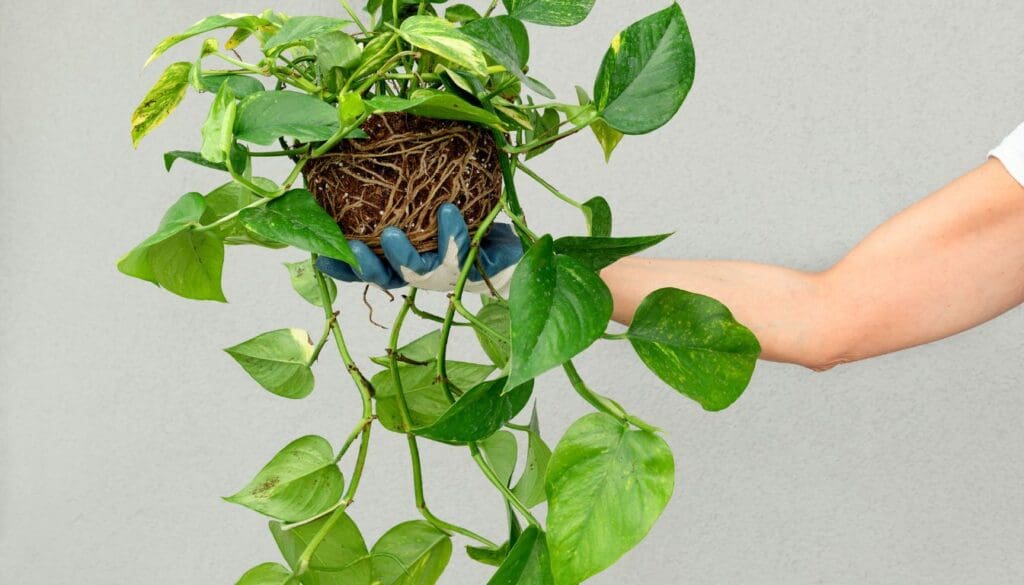
Pothos leaves will turn yellow when the plant gets extremely rootbound.
When Pothos is rootbound, the roots grow circularly, intertwine, and bind tightly.
With such compact roots, transferring nutrients and moisture to the other plant parts and leaves is challenging, resulting in yellowing.
The apparent signs of rootbound are roots coming out of drainage holes and poking from the soil surface.
Repotting Pothos to prevent yellowing
To stop yellowing in Pothos, repot the plant.
Choose a pot 1-2 inches bigger than the old one to give room to the roots.
To prevent rootbound conditions, repot your Pothos every 1-2 years during the spring or summer.
Since it is the plant’s active growth season, it can encourage fast recovery.
6. Environmental Stress Causing Yellow Leaves on Pothos
Environmental stress, like extreme temperatures or repotting shock, can cause yellowing.
Pothos prefer 65-90°F temperatures.
Extremely cold or hot weather stresses the plant and triggers yellowing.
Cold or hot drafts can escalate the issue and increase yellowing.
Repotting stress is another condition where Pothos get stressed, and the leaves turn yellow.
The plant experiences stress due to leaf trimming, root trimming, and changes in its growing environment.
Fixing the temperature and caring for Pothos after repotting
Remove your Pothos from drafty doors and windows.
Relocate it to a place that receives consistent temperature, between 65°F and 90°F.
Sometimes, gardeners keep their Pothos in an AC room during hot weather and a heating room during cold weather.
If you do this, maintain at least 8-10 ft. in between.
As for the repotting stress, you cannot do anything except care for your plant and avoid further stress.
To reduce repotting stress:
- Use the same soil mix you used previously, provided it worked well.
- Maintain hydration for your Pothos.
- Place your Pothos in the same spot as before to avoid changes.
- Make sure the plant receives bright indirect sunlight.
- Avoid extreme temperatures and drafts, and maintain 50-60% humidity.
- Avoid feeding until you notice new growth.
7. Pests Causing Yellow Leaves in Pothos Plants
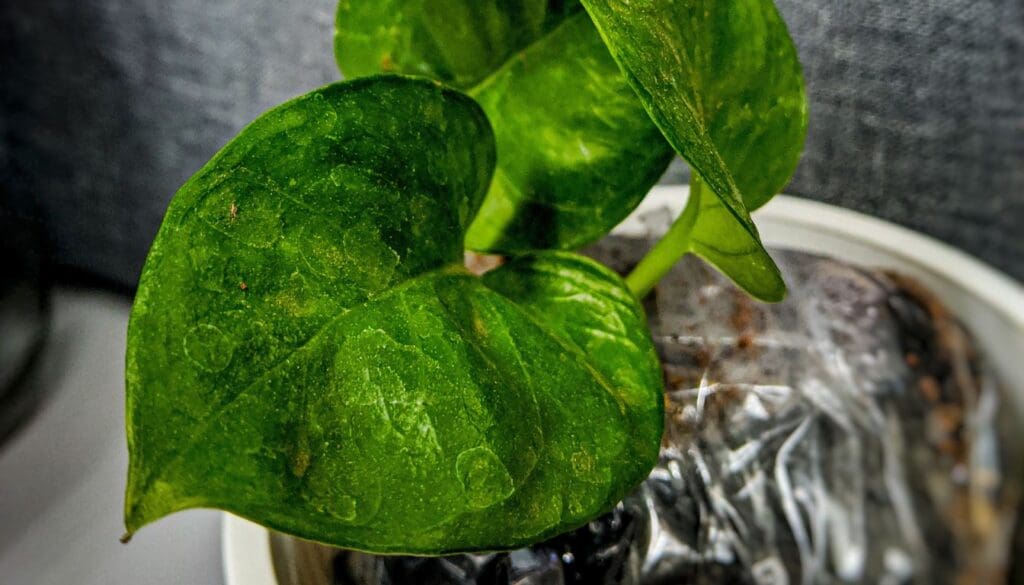
Sap-sucking bugs like aphids, mealybugs, whiteflies, and spider mites drain your Pothos’ sap and nutrients, weakening them and resulting in yellow leaves.
As soon as you recognize that pests attack your Pothos, take immediate action. Once settled, pests can spread like fire.
Dealing with pests and disease to treat yellow leaves in Pothos
- Isolate your Pothos and trim the heavily-infested leaves.
- Spray neem or horticultural oils on the infected areas, mainly under the leaves as they stay.
- Release beneficial insects like ladybugs and lacewings.
- Wipe the infected leaves with a cotton ball dipped in rubbing alcohol.
- Put sticky traps for the flying bugs like thrips.
- Spray diatomaceous earth around the Pothos soil and pot.
- If the infestation is large, use insecticidal soaps and pesticides containing imidacloprid, pyrethrins, and pyrethroids.
8. Diseases Leading to Yellow Pothos Leaves
Several bacterial and fungal diseases can result in yellow leaves on Pothos.
Here are some diseases:
- Root rot from excessive moisture rots and damages the roots, hindering the moisture and nutrient uptake and triggering yellowing in the Pothos leaves.
- Powdery mildew results from high humidity and lack of airflow. Pothos leaves will initially have white powder-scattered signs. Gradually, the leaves turn yellow.
- Aerial blight is a disease that produces yellow leaves with dark blotches.
- In Bacterial leaf spots, Pothos leaves will have yellowing that appears as halos around soft, mushy spots.
- Southern blight disease is caused by the fungus Sclerotium rolfsii, which develops in wet soils and hot weather. The lower leaves will become yellow with dark spots, and white fungal threads grow on the stems and soil.
Disease control in Pothos
Various diseases can cause yellowing in Pothos, and each requires a specific treatment.
If you have any of the mentioned diseases, here’s what you should do:
- For aerial blight, isolate the plant. Prune the discolored leaves and repot the plant in a new, sanitized pot with a new potting mix. Unfortunately, the plant is not guaranteed to recover from the blight.
- To treat powdery mildew, isolate your Pothos and apply neem oil or fungicides. Keep the humidity around 50-60%. Increase airflow by running a fan, opening the windows (if there aren’t any drafts), maintaining distance from other plants, and pruning overgrown leaves.
- For bacterial leaf spots, isolate and remove the infected Pothos leaves and petioles and apply bactericide. Avoid overhead watering and misting on the leaves.
- Southern blight cannot be treated. If it occurs, discard your Pothos. Disinfect the surroundings. Treat the remaining healthy plants near Pothos with a fungicide solution containing pentachloronitrobenzene (PCNB) or flutolanil.
- Root rot needs a different treatment:
- Remove the discolored leaves and take your Pothos out of the pot.
- Clean the roots and examine them.
- If maximum roots are damaged, collect some healthy cuttings for propagation. If minimal root damage has occurred, remove the brown and mushy roots.
- Spray fungicide on the remaining roots or soak them in a solution of hydrogen peroxide and water (1:4) for 30 minutes.
- Repot your plant in a new pot with a new, well-drained soil mix.
- Provide dappled sun and water properly, and prevent drafts.
- Fertilize once you notice new growth.

9. Chemical Contaminants in Soil Turning Pothos Leaves Yellow
There are two conditions where Pothos will have chemical buildup and cause yellowing:
- Manganese toxicity results in bacterial wilt and southern blights in the younger plants. It happens when young nursery Pothos absorb too much manganese from commercial fertilizers.
- Ethylene damage, turning Pothos leaves yellow, often occurs in cold weather due to fungicides, decaying plant materials, or faulty heaters affecting airflow.
Getting rid of the chemical buildup to avoid yellow leaves in Pothos
To fix manganese toxicity, stop using your present fertilizer and replace it with a fertilizer without manganese.
Avoid products where maneb or mancozeb is mentioned, signifying manganese’s presence.
Add lime to your soil to adjust the nutrient level.
To fix ethylene damage, avoid using excessive fungicides.
Improve air circulation around your plant. Use good-quality heaters to provide warmth to your Pothos.
Note: If you are doing everything correctly for your Pothos and it looks healthy, yellow leaves are the old leaves. Old leaves naturally turn yellow or brown, dry, and fall off. You may remove them for a clean appearance in your Pothos. This issue has no solution as it is a natural process in Pothos.
Preventing Yellow Leaves in Pothos
Follow proper care tips and provide the right requirements to your Pothos to prevent yellow leaves. Here are a few of them:
- Pothos should receive 10-12 hours of bright, indirect sunlight.
- Pothos soil’s top few inches should dry before each watering session.
- Use well-drained fertile soil mix with 6.1-6.8 pH levels for Pothos.
- Fertilize your Pothos every 4-6 weeks with a balanced liquid fertilizer and 1-2 times a year with a slow release during the spring and summer. Always dilute your fertilizer to half the recommended strength. Avoid winter feeding.
- Maintain 65-90°F temperature and 50-60% humidity for Pothos.
- Maintain good air circulation around your Pothos.
- Avoid fertilizers with high manganese and use high-quality heaters to warm your Pothos.
- Repot your Pothos every 1-2 years when it overgrows. Provide good care to reduce repotting stress and encourage quick recovery.
Final thoughts
Numerous reasons can lead to yellow leaves in Pothos. Common reasons are incorrect watering, poor light, poor drainage and soil quality, improper fertilization, temperature stress, environmental stress, pests and diseases, and chemical contamination.
If your Pothos look healthy and still have yellow leaves, it’s aging. Since multiple reasons can lead to yellowing, diagnose your Pothos properly and give the correct treatment.
Provide correct care tips and requirements to prevent yellow leaves in Pothos in the future.
Will the yellow leaves of your Pothos turn green?
Unfortunately, the yellow Pothos leaves won’t turn green. They will gradually fall off. New leaves will be green if you provide the proper care.
Should I remove the yellow leaves?
Generally, the yellow leaves fall off on their own. But you can remove them beforehand to improve the plant’s appearance and encourage new growth.
Reference: Pothos Wikipedia , Chlorosis or Yellow leaves Wikipedia
Recommended Garden Supplies
| Product Image | Our Recommended Gardening Supplies | Check Offers! |
|---|---|---|
Top Top
Top
Top
Top
Top
Top
Top
Top | rePotme Houseplant and Tropical Classic Potting Soil Mix | Check Offer On Amazon |
 Top
Top
Top
Top
Top
Top
Top
Top | Espoma Organic Indoor Plant Food | Check Offer On Amazon |
 Top
Top
Top
Top
Top
Top
Top
Top | GooingTop LED Grow Light 6000K Full Spectrum Clip Plant Growing Lamp | Check Offer On Amazon |
 Top
Top
Top
Top
Top
Top
Top
Top | Soil Moisture Meter | Check Offer On Amazon |
 Top
Top
Top
Top
Top
Top
Top
Top | Govee Hygrometer Thermometer, Bluetooth Enabled! | Check Offer On Amazon |
 Top
Top | LEVOIT Humidifiers for Large Room(Best For Plants) | Check Offer On Amazon |
 Top
Top
Top
Top
Top
Top
Top
Top | Upgraded DIY Automatic Drip Irrigation Kit, 15 Potted Houseplants Support | Check Offer On Amazon |
 Top
Top
Top
Top
Top
Top
Top
Top | Stainless Steel Heavy Duty Gardening Tool Set | Check Offer On Amazon |
 Top
Top
Top
Top
Top
Top
Top
Top | Bonide Insecticidal Soap | Check Offer On Amazon |
 Top
Top
Top
Top
Top
Top
Top
Top | Bonide 32 oz Spray Neem Oil for Organic Gardening | Check Offer On Amazon |
 Top
Top
Top
Top
Top
Top
Top
Top | Garden Safe Fungicide | Check Offer On Amazon |



